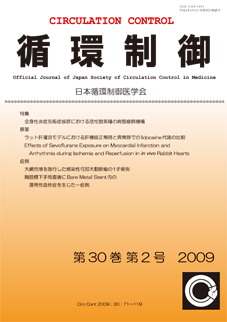巻号一覧

30 巻 (2009)
- 3 号 p. 165-
- 2 号 p. 82-
- 1 号 p. 8-
30 巻, 2 号
選択された号の論文の4件中1~4を表示しています
- |<
- <
- 1
- >
- >|
原著
-
須崎 範子, 定松 舞子, 片上 智裕, 曽我 祐子, 門林 孝明, 佐々木 大輔, 廣谷 芳彦, 加藤 隆児, 井尻 好雄, 田中 一彦2009 年 30 巻 2 号 p. 82-87
発行日: 2009年
公開日: 2013/05/31
ジャーナル フリーLidocaine(LID)は抗不整脈薬として用いられる薬物で,重篤な心室性不整脈を起こした緊急時の第一選択薬となっている.このため,緊急時には肝機能評価を行うことなく投与される可能性がある.そこで,ラット肝灌流モデルにおける肝正常時と肝障害時における LID の薬物動態を調べる目的で,灌流液中 LID とその代謝物である monoethylglycinexylidide(MEGX)の薬物動態学的パラメータを測定した.肝機能測定の結果より,灌流開始 30 分を肝正常時,150 分を肝障害時とし,LID 3mg/kg の投与を行った.その結果,AUCMEGX は灌流開始 150 分後の LID 投与において有意な増加が認められたが,それ以外のパラメータに有意な変化は認められなかった.また,灌流液中の MEGX 代謝に関わるエステラーゼ量が灌流開始直後より低下したため,MEGXの代謝・消失が遅延した可能性も考えられた.これより,肝血流量が一定である場合はある程度の肝障害を起こしている場合でも,LID は通常の投与量で投与可能であることが示唆された.抄録全体を表示PDF形式でダウンロード (324K) -
Hisashi Beppu, Uno Imaizumi, Munetaka Furuya, Kazutoshi Higuchi, Hitos ...2009 年 30 巻 2 号 p. 88-94
発行日: 2009年
公開日: 2013/05/31
ジャーナル フリーThe effects of sevoflurane on myocardial ischemia and reperfusion injury have not been well studied, especially in in vivo model. The present study aimed to investigate the effect of timing and duration of sevoflurane exposure on the intensity of myocardial response, and ischemia/reperfusion arrhythmias.
All anesthetized open-chest rabbits underwent 30 min of left anterior descending coronary artery(LAD) occlusion followed by 3 hrs of reperfusion. In the control group(C), and sevoflurane group(S), rabbits were subjected to 30 min of LAD occlusion and 3 hrs of reperfusion under ketamine/xylazine(k/x) or sevoflurane anesthesia respectively. The ischemia-preconditioned rabbits underwent 5 min of LAD occlusion followed by 10 min of reperfusion under k/x anesthesia(C-IP), or sevoflurane(S-IP). In the sevoflurane-preconditioned group(C-SP), 30 min of sevoflurane exposure at a 1.5% end-tidal concentration was followed by 15 min of washout before 30 min of LAD occlusion and 3 hrs of reperfusion under k/x anesthesia. At the end of 3-hrs reperfusion period, area at risk was delineated by Evans blue and infarct size determined by triphenyltetrazolium chloride(TTC) staining. The rate pressure product did not alter significantly at any point among all the groups. Compared with group C, myocardial protective effect was observed in groups of S, C-IP, S-IP and C-SP. However, infarct size in sevoflurane-preconditioned group was significantly larger than those of S and S-IP groups. Also, infarct limiting effect of S-IP group was significantly intensified compared with C-IP and S. Continuous exposure of sevoflurane reduced arrhythmias during not only ischemia but reperfusion period in rabbit hearts.
These results suggested that continuous sevoflurane exposure might confer additive infarct limiting effect on ischemic preconditioning. We found that ischemic preconditioning and sevoflurane preconditioning do not have anti-arrhythmic effect, though sevoflurane exposure has anti-arrhythmic effects against ischemia and reperfusion-induced arrhythmia.抄録全体を表示PDF形式でダウンロード (251K)
症例
-
岡田 修一, 金子 達夫, 江連 雅彦, 佐藤 泰史, 長谷川 豊, 小池 則匡, 小此木 修一, 滝原 瞳2009 年 30 巻 2 号 p. 95-99
発行日: 2009年
公開日: 2013/05/31
ジャーナル フリーA 56-year-old female was admitted to a hospital due to fever and back pain. She was diagnosed of asthmatic bronchitis and received antibiotic therapy. But two weeks later she complained of back pain again. Her white blood cells and C-reactive protein(CRP) were elevated and computed tomography(CT) revealed aortic arch aneurysm. Two weeks later, she was referred to our hospital. CT revealed rapid enlargement of the aneurysm. She was diagnosed of mycotic descending aortic aneurysm and underwent resection of the aneurysm and in situ prosthetic graft replacement and omentopexy around the graft. She received antibiotic therapy until the day 52 postoperatively. Their postoperative courses were good and no recurrence of infection was seen.抄録全体を表示PDF形式でダウンロード (529K) -
二木 貴弘, 國吉 保, 磯脇 純和, 永田 悦朗, 松永 明, 上村 裕一2009 年 30 巻 2 号 p. 100-104
発行日: 2009年
公開日: 2013/05/31
ジャーナル フリーWe report a case of late stent thrombosis in the immediate postoperative period of non-cardiac surgery four weeks after a bare metal stent(BMS) implantation. A 77-year old man who was scheduled for thoracoscopic mediastinal lymph node biopsy received preoperatively implantation of BMS for significant stenosis in the proximal left anterior descending coronary artery. The surgery was postponed four weeks after the stent insertion and the dual anti-platelet therapy with aspirin and ticropidine was discontinued one week before the surgery. The surgery was successfully performed under general anesthesia even with episodes of bradycardia and hypotension.
Immediately after the surgery, ST-segment elevation in left precordial leads and acute heart failure appeared following a complete atrioventricular block. An emergency coronary angiogram revealed a thrombotic stenosis of the BMS and a restenting restored the stent patency and its hemodynamics.
In this case, one of the most important factors causing the stent thrombosis must be discontinuation of antiplatelets. It is very difficult to decide whether to continue antiplatelets or not, because the risk of bleeding or stent thrombosis depends on the type of surgery, stent, and antiplatelets and the time between the stenting and the surgery. Therefore, the issues as stated above should be discussed cautiously among the anesthesiologist, surgeon, and treatment physician.抄録全体を表示PDF形式でダウンロード (375K)
- |<
- <
- 1
- >
- >|